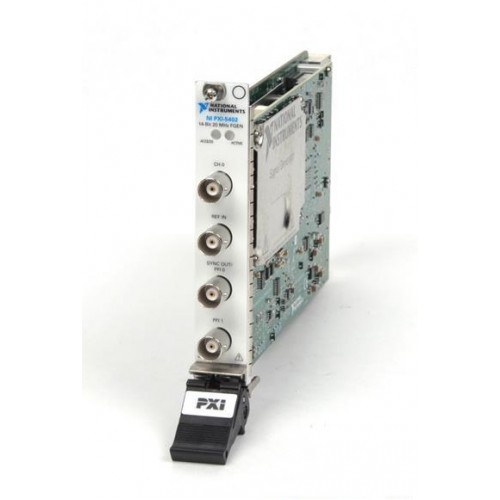
PXI-5402
- Brand: National Instruments
- Product Code: PXI-5402
- Part number: pxi5402
$0.00
Ex Tax: $0.00
Price: $50
Available Options
National Instruments PXI-5402 / PXI-5406 14/16-bit 20/40 MHz Arbitrary Function Generator
Features
The National Instruments PXI-5402 / PXI-5406 14/16-bit 20/40 MHz Arbitrary Function Generator devices are 100 MS/s, 40 and 20 MHz arbitrary function generators (AFGs) that feature up to 16 bits of resolution and 32 kB of onboard memory for arbitrary function generation in a compact, 1-slot 3U PXI module or PCI board. Using these devices, you can combine the power of a stand-alone function generator with the flexibility and benefits of your computer to create highly capable virtual instrumentation solutions. Direct digital synthesis (DDS) is used to precisely generate waveforms that are repetitive in nature, including sine, square, triangle, ramp, noise, and DC waveforms.
These devices feature unparalleled analog output performance in PXI and PCI. The analog output path features a 7-pole elliptical analog filter to suppress high-frequency signal images. Depending on your signal and application needs, you can select up to a 4X digital interpolation for an effective sampling rate up to 400 MS/s. Additionally, the analog output has a passband flatness of ±0.4 dB across the bandwidth for sine generation.
The function generator uses DDS, which is a technique for deriving, under digital control, an analog frequency source from a single reference clock frequency. This technique is used to achieve high-frequency accuracy and resolution; temperature stability; and rapid, phase-continuous frequency switching. All frequency sweeping and hopping is phase-continuous, and you can generate a burst of several tones. Frequency sweeping and hopping is implemented through a frequency list of steps, each of which defines frequency and duration. Complex frequency lists can be instructed with 32 MS/s of available instruction memory.
Using NI-TClk synchronization technology, the user can synchronize multiple NI signal generators for applications requiring a greater number of channels. Because it is built into the Synchronization and Memory Core (SMC), NI-TClk can synchronize NI signal generators with SMC-based high-speed digitizers and digital waveform generator/analyzers for tight correlation of analog and digital stimulus and response. Using on-board calibration measurements and compensation, NI-TClk can automatically synchronize any combination of SMC-based modules with less than 500 psrms module-to-module skew. Greatly improved from traditional synchronization methods, the skew between modules does not increase as the number of modules increases. To achieve even better performance, you can use a high-bandwidth oscilloscope to precisely measure the module-to-module skew. Using the oscilloscope measurement for calibration information, NI-TClk can achieve <-20 psrms module-to-module skew.
Features
- Phase-Continuous Frequency Hopping and Frequency Sweeps
- 400 MS/s Effective Sample Rate with Interpolation
- 0.355 µHz Frequency Resolution
- <±0.4 dB Passband Flatness Across Bandwith for Sine Waveforms
- NI-TClk Technology for Timing and Synchronization
- Built-In Sine, Square, Triangle, Noise Ramp Up, Ramp Down and DC Offset Functions
The National Instruments PXI-5402 / PXI-5406 14/16-bit 20/40 MHz Arbitrary Function Generator devices are 100 MS/s, 40 and 20 MHz arbitrary function generators (AFGs) that feature up to 16 bits of resolution and 32 kB of onboard memory for arbitrary function generation in a compact, 1-slot 3U PXI module or PCI board. Using these devices, you can combine the power of a stand-alone function generator with the flexibility and benefits of your computer to create highly capable virtual instrumentation solutions. Direct digital synthesis (DDS) is used to precisely generate waveforms that are repetitive in nature, including sine, square, triangle, ramp, noise, and DC waveforms.
These devices feature unparalleled analog output performance in PXI and PCI. The analog output path features a 7-pole elliptical analog filter to suppress high-frequency signal images. Depending on your signal and application needs, you can select up to a 4X digital interpolation for an effective sampling rate up to 400 MS/s. Additionally, the analog output has a passband flatness of ±0.4 dB across the bandwidth for sine generation.
The function generator uses DDS, which is a technique for deriving, under digital control, an analog frequency source from a single reference clock frequency. This technique is used to achieve high-frequency accuracy and resolution; temperature stability; and rapid, phase-continuous frequency switching. All frequency sweeping and hopping is phase-continuous, and you can generate a burst of several tones. Frequency sweeping and hopping is implemented through a frequency list of steps, each of which defines frequency and duration. Complex frequency lists can be instructed with 32 MS/s of available instruction memory.
Using NI-TClk synchronization technology, the user can synchronize multiple NI signal generators for applications requiring a greater number of channels. Because it is built into the Synchronization and Memory Core (SMC), NI-TClk can synchronize NI signal generators with SMC-based high-speed digitizers and digital waveform generator/analyzers for tight correlation of analog and digital stimulus and response. Using on-board calibration measurements and compensation, NI-TClk can automatically synchronize any combination of SMC-based modules with less than 500 psrms module-to-module skew. Greatly improved from traditional synchronization methods, the skew between modules does not increase as the number of modules increases. To achieve even better performance, you can use a high-bandwidth oscilloscope to precisely measure the module-to-module skew. Using the oscilloscope measurement for calibration information, NI-TClk can achieve <-20 psrms module-to-module skew.
Services Tab text here
Manuals Tab text here
